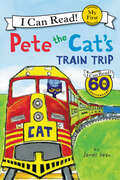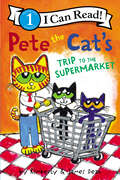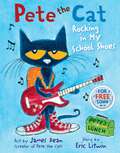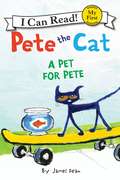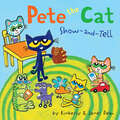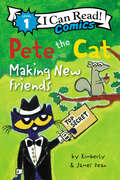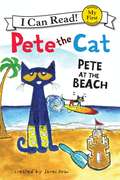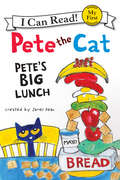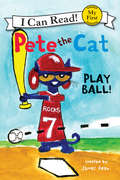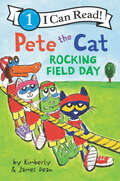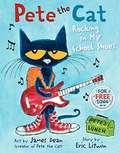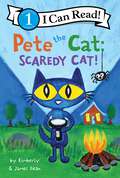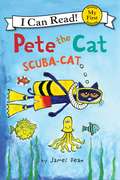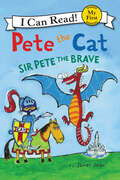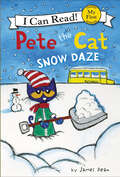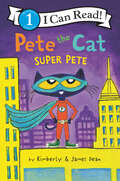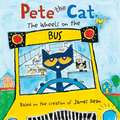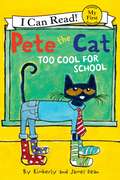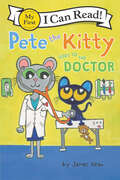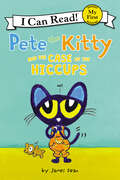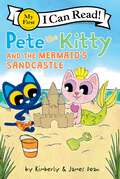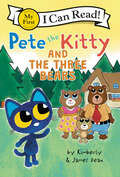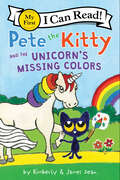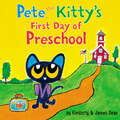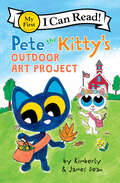- Table View
- List View
Pete the Cat's Train Trip (My First I Can Read)
by Kimberly Dean James DeanNew York Times bestselling author and artist James Dean brings young readers along on a groovy train ride with Pete the Cat! Pete can't wait to visit Grandma, especially because he gets to take a train ride to see her! The conductor gives Pete a tour of the train, and Pete gets to see the engine and honk the horn. Pete even makes new friends and plays games on board. What a cool ride!Pete the Cat's Train Trip is a My First I Can Read Book, which means it's perfect for shared reading with a child. Fans of Pete the Cat will delight as Pete takes the grooviest train trip in this hilarious I Can Read adventure.
Pete the Cat's Trip to the Supermarket (I Can Read Level 1)
by Kimberly Dean James DeanPete the Cat helps out at the supermarket in this Level 1 I Can Read tale from New York Times bestselling creators Kimberly and James Dean.Along with his dad and brother, Pete the Cat heads off to the supermarket. But what happens when Dad loses the grocery list before they even get there? It’s up to Pete and Bob to help remind Dad what was on their list!Pete the Cat's Trip to the Supermarket is a Level I Can Read book, complete with original illustrations from the creators of Pete the Cat, Kimberly and James Dean, and is perfect for children learning to sound out words and sentences. Whether shared at home or in a classroom, the short sentences, familiar words, and simple concepts of Level One books support success for children eager to start reading on their own.
Pete the Cat: A Back to School Book for Kids (Pete the Cat)
by Kimberly Dean Eric LitwinTime to head back to school with this bestselling groovy Pete the Cat book!Pete the Cat is rocking in his school shoes. Pete discovers the library, the lunch room, the playground, and lots of other cool places at school.And no matter where he goes, Pete never stops moving and grooving and singing his song...because it’s all good.The fun never stops—download the free groovin’ song.Don't miss Pete's other adventures, including Pete the Cat: I Love My White Shoes, Pete the Cat and His Four Groovy Buttons, Pete the Cat Saves Christmas, Pete the Cat and His Magic Sunglasses, Pete the Cat and the Bedtime Blues, Pete the Cat and the New Guy, Pete the Cat and the Cool Cat Boogie, Pete the Cat and the Missing Cupcakes, Pete the Cat and the Perfect Pizza Party, and Pete the Cat: Crayons Rock!
Pete the Cat: A Pet for Pete (My First I Can Read)
by Kimberly Dean James DeanPete the Cat is back with another groovy I Can Read adventure from New York Times bestselling author and artist James Dean.Pete the Cat can’t wait to get a new pet! He gets a goldfish he names Goldie. Pete paints a cool painting of Goldie and now everyone wants a piece of it! But Pete doesn't have enough time to make one for everyone. Will Pete find a way to have fun painting Goldie and have time to finish his homework? From New York Times bestselling artist and author James Dean, Pete the Cat: A Pet for Pete is a My First I Can Read Book, which means it's perfect for shared reading with a child.
Pete the Cat: Includes Over 30 Stickers! (Pete the Cat)
by Kimberly Dean James DeanPete the Cat and his friends show off their favorite toys in this super cool storybook from New York Times bestselling author-illustrator team Kimberly and James Dean. Includes over 30 stickers!Pete the Cat can’t wait for show-and-tell. He knows just what to bring—his baseball glove! But when he sees what everyone else is sharing, he starts to worry. Is his glove actually cool enough? Join Pete the Cat and his friends as they learn the true meaning of cool!
Pete the Cat: Making New Friends (I Can Read Comics Level 1)
by Kimberly Dean James DeanPete the Cat makes his I Can Read Comics debut! From New York Times bestselling author-illustrator team James and Kimberly Dean comes the very first I Can Read Comics Level One book in the Pete the Cat series! In Pete the Cat: Making New Friends, Secret Agent Meow, also known as Pete the Cat, is ready to crack the case! Join Pete and Squirrel as they go on a mission to make new friends. Pete the Cat: Making New Friends is a Level One I Can Read Comic, which means it will introduce children into the world of graphic novel storytelling and encourage visual literacy in emerging readers.
Pete the Cat: Pete at the Beach (My First I Can Read)
by Kimberly Dean James DeanNew York Times bestselling author and artist James Dean brings Pete the Cat fans some fun in the sun! Pete the Cat is one groovy cat at finding shells and building sand castles at the beach. But when it gets too hot, there’s only one way to cool off—jump into the ocean! Except Pete might be a scaredy-cat when it comes to the water.Pete the Cat: Pete at the Beach is a My First I Can Read book, which means it’s perfect for shared reading with a child.
Pete the Cat: Pete's Big Lunch (My First I Can Read)
by Kimberly Dean James DeanNew York Times bestselling author and artist James Dean brings young readers a lunchtime treat! Pete the Cat makes one giant, tasty sandwich for lunch. But what's the fun in eating lunch without your friends? Pete the Cat fans will enjoy Pete's funny food creativity and Pete's joy in sharing with friends. Pete the Cat: Pete’s Big Lunch is a My First I Can Read book, which means it’s perfect for shared reading with a child.
Pete the Cat: Play Ball! (My First I Can Read)
by Kimberly Dean James DeanNew York Times bestselling author and artist James Dean takes readers along for a fun, groovy adventure with Pete the Cat!Pete the Cat is ready to play baseball! Pete’s team, the Rocks, is playing the Rolls. But when the game doesn’t go Pete’s way, what will Pete do?Pete the Cat: Play Ball! is a My First I Can Read book, which means it’s perfect for shared reading with a child.
Pete the Cat: Rocking Field Day (I Can Read Level 1)
by Kimberly Dean James DeanFrom New York Times bestselling author-illustrator team Kimberly and James Dean comes a brand new I Can Read book in which Pete and his friends compete in Field Day!Ready, set, groove! It’s field day and Pete is excited for a day filled with fun activities, like the water-balloon toss, three-legged race, an obstacle course, and tug-of-war! Join Pete the Cat and his friends Callie, Grumpy Toad, and Gus as they compete for a medal on field day!Pete the Cat: Rocking Field Day is a Guided Reading Level J and a Level One I Can Read, which means it’s perfect for children learning to sound out words and sentences. Whether shared at home or in a classroom, the short sentences, familiar words, and simple concepts of Level One books support success for children eager to start reading on their own.
Pete the Cat: Rocking in my School Shoes (Into Reading, Big Book Module 1)
by Eric Litwin James DeanNIMAC-sourced textbook <P><P>Time to head back to school with this bestselling groovy Pete the Cat book! <P><P>Pete the Cat is rocking in his school shoes. Pete discovers the library, the lunch room, the playground, and lots of other cool places at school. And no matter where he goes, Pete never stops moving and grooving and singing his song...because it’s all good. <P><P>The fun never stops—download the free groovin’ song. <P><P>Lexile Measure: AD430L
Pete the Cat: Scaredy Cat! (I Can Read Level 1)
by Kimberly Dean James DeanA scary story spooks Pete the Cat in this Level 1 I Can Read from New York Times bestselling creators Kimberly and James Dean.When Bob tells Pete the Cat a spooky, creepy, scary story about a monster, Pete is a little scared. The monster seems to be everywhere he looks! What will help Pete overcome his fear?Find out in this Level 1 I Can Read book complete with original illustrations from the creators of Pete the Cat, Kimberly and James Dean. Pete the Cat: Scaredy Cat! is perfect for children learning to sound out words and sentences. Whether shared at home or in a classroom, the short sentences, familiar words, and simple concepts of Level One books support success for children eager to start reading on their own.
Pete the Cat: Scuba-cat (My First I Can Read)
by Kimberly Dean James DeanNew York Times bestselling author and artist James Dean brings Pete the Cat’s world to life under the sea in this new I Can Read book.Pete the Cat is going scuba diving! Before he hits the water, Captain Joe tells him about all the sea creatures he can encounter, and Pete is super excited to see a seahorse. But when he is suited up and swimming around, he has to search high and low to find the little guy. In this aquatic adventure, Pete makes a new friend and gets a big surprise!Pete the Cat: Scuba-Cat is a My First I Can Read Book, which means it’s perfect for shared reading with a child. New readers will love the easy-to-read format and groovy illustrations in Pete the Cat’s first I Can Read underwater journey!
Pete the Cat: Sir Pete the Brave (My First I Can Read)
by Kimberly Dean James DeanNew York Times bestselling author and artist James Dean brings readers a new story about the most gallant cat around—Pete! This time Pete is a knight on an adventure to save a pal in Pete the Cat: Sir Pete the Brave.When Lady Callie, the most awesome harpist in all the land, goes missing, it’s up to Sir Pete to save her. But when he ends up trapped in a dragon’s lair, Lady Callie might have to do the saving.Pete the Cat: Sir Pete the Brave is a My First I Can Read book, which means it’s perfect for shared reading with a child.
Pete the Cat: Snow Daze (My First I Can Read)
by Kimberly Dean James DeanNew York Times bestselling author and artist James Dean brings readers along for a fun, surprising, snowy adventure with Pete the Cat! In Pete the Cat: Snow Daze, school is canceled, and Pete cannot wait to play in the snow with all his friends. Imagine a day filled with snowball fights, hot chocolate, snowcats, and more. But when the next day and the day after that are all snow days, Pete comes to a sudden realization—it is possible to have too many snow days.Pete the Cat: Snow Daze is a My First I Can Read book, which means it’s perfect for shared reading with a child.
Pete the Cat: Super Pete (I Can Read Level 1)
by Kimberly Dean James DeanFrom New York Times bestselling creators Kimberly and James Dean, Pete the Cat becomes...Super Pete! We all need a superhero Pete in our life.When there's trouble in town, it’s up to Pete the Cat's alter ego, Super Pete, to save the day! With his cool jet, nifty goggles, and slick slingshot, Super Pete is ready to take down any bad guys.Pete the Cat: Super Pete is a Level 1 I Can Read book, which means it's perfect for shared reading with a child and any heroes-in-training.
Pete the Cat: The Wheels on the Bus (Pete the Cat)
by Kimberly Dean James DeanPete the Cat leads kids back to school with this fun version of the classic song.Pete the Cat can't wait to take the school bus all the way to school! Everyone's favorite cat is groovier than ever in this way-cool adaptation of the classic kids' song "The Wheels on the Bus."The kitties on the bus say, "Come on, Pete! Come on, Pete!" The kitties on the bus say, "Conme on, Pete! Hop on board!"New York Times bestselling artist and author James Dean adds a groovy vibe to his cool adaptation of "The Wheels on the Bus" with Pete the Cat. Hop on board with Pete and his friends as they sing the classic school bus tune. Fans of Pete the Cat will love singing along with Pete in this groovy rendition of this favorite children's song.
Pete the Cat: Too Cool for School (My First I Can Read)
by Kimberly Dean James DeanIf you want to be cool, just be YOU! That's the message of this funny, relatable Pete the Cat school story—and kids will laugh and agree.Pete the Cat can't decide what to wear to school in Pete the Cat: Too Cool for School. With so many groovy options to choose from, Pete just keeps adding on.All of Pete's friends have a suggestion for what he should wear to school. But by the time he's added cowboy boots, shorts with fish, his red shirt AND his yellow shirt—and even more—he's too hot.It's time to make his own clothing decisions and head back to school! You and your kids will giggle at Pete and his clothing choices, resolved with a positive empowering message.Pete the Cat: Too Cool for School is a My First I Can Read book. Each My First I Can Read book is carefully crafted using basic language, word repetition, sight words, and sweet illustrations—which means it's perfect for shared reading with emergent readers. The active, engaging My First I Can Read stories have appealing plots and lovable characters, encouraging children to continue their reading journey.
Pete the Kitty Goes to the Doctor (My First I Can Read)
by Kimberly Dean James DeanOh no! Pete the Kitty has a tummy ache. Good thing his dad knows just what to do. It’s time to go to the doctor!Except Pete may be a teensy-weensy bit nervous about his first visit to the doctor. With the help of his dad, Pete discovers the doctor isn’t scary.Beginning readers will easily relate to Pete the Kitty as he overcomes his fear of going to the doctor's office.This My First I Can Read book is carefully crafted using basic language, word repetition, sight words, and sweet illustrations—which means it's perfect for shared reading with emergent readers. The active, engaging My First I Can Read stories have appealing plots and lovable characters, encouraging children to continue their reading journey.From New York Times bestselling author/illustrator team Kimberly and James Dean, it's everyone’s favorite kitty, Pete the Kitty!
Pete the Kitty and the Case of the Hiccups (My First I Can Read)
by Kimberly Dean James DeanBeginning readers will laugh and easily relate to Pete the Kitty and his search for the perfect remedy for his hiccups!Pete gets a case of the hiccups, and he doesn’t know what to do. He decides to ask his wisest friends for help, like Grumpy Toad, Callie, and Bob. But Pete is still stuck with the hiccups. Will Pete the Kitty ever get rid of his terrible hiccups?This My First I Can Read book is carefully crafted using basic language, word repetition, sight words, and sweet illustrations—which means it's perfect for shared reading with emergent readers. The active, engaging My First I Can Read stories have appealing plots and lovable characters, encouraging children to continue their reading journey.This is the very first Pete the Kitty I Can Read favorite from New York Times bestselling Pete the Cat author-artist James Dean!
Pete the Kitty and the Mermaid's Sandcastle (My First I Can Read)
by Kimberly Dean James DeanA magical mermaid adventure from New York Times bestselling creators Kimberly and James Dean!Pete the Kitty and his mermaid friend Jessie work together to build a sandcastle. But the castle is missing something. Will one shell, two barnacles, three strands of seaweed, and more gifts from the sea be enough to make their sandcastle the best it can be?Young mermaid fans and beachgoers will love building and counting with Pete and Jessie in this My First I Can Read story, complete with original illustrations from the creator of Pete the Cat, James Dean.This My First I Can Read book is carefully crafted using basic language, word repetition, sight words, and sweet illustrations—which means it's perfect for shared reading with emergent readers. The active, engaging My First I Can Read stories have appealing plots and lovable characters, encouraging children to continue their reading journey.
Pete the Kitty and the Three Bears (My First I Can Read)
by Kimberly Dean James DeanJoin Pete the Kitty as he visits the three bears in this I Can Read story from New York Times bestselling team Kimberly and James Dean.Once upon a time, there was a kitty named Pete who came upon a house in the forest. He goes in, eats pizza, plays guitar, and falls asleep. But what happens when three bears come home?Beginner readers will love this new Pete-tastic spin on the beloved fairy tale Goldilocks and the Three Bears!This My First I Can Read book is carefully crafted using basic language, word repetition, sight words, and sweet illustrations—which means it's perfect for shared reading with emergent readers. The active, engaging My First I Can Read stories have appealing plots and lovable characters, encouraging children to continue their reading journey.
Pete the Kitty and the Unicorn's Missing Colors (My First I Can Read)
by Kimberly Dean James DeanA magical unicorn adventure from New York Times bestselling creators Kimberly and James Dean!Pete the Kitty's friend Stevie the unicorn somehow lost all the colors in her rainbow tail. It’s a good thing Pete has his magical paintbrush to help out. Together, they search for the missing colors of the rainbow.Young unicorn fans will love Pete's enchanting adventure in this My First I Can Read story, complete with original illustrations from the creator of Pete the Cat, James Dean.My First I Can Read books are perfect for shared reading with a child. Books at this level feature basic language, word repetition, and whimsical illustrations, ideal for sharing with emergent readers. The active, engaging stories have appealing plots and lovable characters, encouraging children to continue their reading journey.
Pete the Kitty's First Day of Preschool (Pete the Cat)
by Kimberly Dean James DeanPete the Kitty is almost ready for his first day of preschool! Preschoolers and little ones getting ready to go to preschool for the first time will enjoy cheering Pete the Kitty's fun entry to preschool.It's a big day for Pete the Kitty: his first day of preschool! He meets his cool teacher, sings a few fun songs, and even gets to paint. Who knew preschool could be so much fun?Just don't forget your groovy backpack and your yummy snack, Pete the Kitty!Little ones will enjoy exploring what the first day of school is like with Pete the Kitty.
Pete the Kitty's Outdoor Art Project (My First I Can Read)
by Kimberly Dean James DeanJoin Pete the Kitty as he gets creative in this I Can Read story from New York Times bestselling team Kimberly and James Dean.Pete the Kitty loves art class. But when the project is to go outside and make art from nature, Pete isn’t sure what to create. Then inspiration strikes and Pete realizes that nature art is cooler than he ever imagined!Beginner readers will love creating nature art with Pete!This My First I Can Read book is carefully crafted using basic language, word repetition, sight words, and sweet illustrations—which means it's perfect for shared reading with emergent readers. The active, engaging My First I Can Read stories have appealing plots and lovable characters, encouraging children to continue their reading journey.
